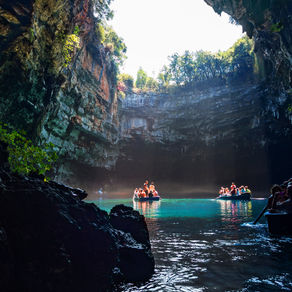Moustos Wetland | Arcadia Highlands | Therapy in Thyreatis Plain and the Mystery of the Beast
- Shiny Greece
- May 29, 2018
- 4 min read
Updated: Mar 25
Author
George - The Shiny Greece Team (feat. ai)
The Moustos Wetland, nestled just a few kilometers (south) from Astros Arcadia, before the villages Leonidio and Tyros, captivates visitors with its breathtaking beauty and rich biodiversity. Dividing the Thyreatis plain into two parts, the plain of Astros and the plain of Agios Andreas, this wetland has a fascinating history and plays a vital role in the region's ecosystem. The wetland includes a small lake and a swamp, with two channels connecting it with the sea. The lake is supplied from a thermal spring, one of the main reasons that the area attracts many tourists who come for therapeutic reasons. As a protected area integrated into the Natura 2000 European Network, the Moustos Wetland safeguards numerous migratory bird species and supports a diverse range of flora and fauna. Let us delve into the wonders of Moustos Wetland and discover why it is a must-visit destination for nature enthusiasts.

Moustos Wetland | Photo by: iStock.com, Olga_Anourina
Moustos means grape must. The area is well known for its viticulture and Moustos used to be an old port of Astros where grape must was loaded on ships. The lake has rich fauna and flora, consisting of migratory birds (ducks, herons and more), reptiles, fish and turtles (Caretta-Caretta nests here too).
History of Moustos
Moustos Wetland has a rich history dating back to the 1950s when it covered a vast area of 2,500 acres. However, due to the expansion of croplands and the draining of marshy areas, its current size is limited to 850 acres. The wetland comprises two main coastal lakes, the homonymous lake, and the smaller Heronisi. These lakes, connected to the sea by two artificial canals known as the "Bavarian" canals, were created by the Bavarian engineer Otto to combat malaria and reclaim land for agriculture. In the early 20th century, Moustos Wetland teemed with fish, and fishing rights were granted to the locals. The legend of the "Beast of Moustos" added an air of mystery to the area, with tales of its nocturnal roars reaching the mountains.

Moustos Lagoon | Photo by: Demiesk, Limnothalassa Moustou 1, CC BY-SA 4.0
An Ecological Haven
Designated as a protected area within the Natura 2000 European Network, Moustos Wetland serves as a refuge for migratory birds during winter. This picturesque wetland houses wild swans, herons, mallards, and Eurasian coots. It boasts an array of flora, including reeds, thorns, alders, and beautiful flowering plants such as white crocus, red and white anemones, Greek cyclamens, poppies, and the fragrant White Narcissus, locally known as Manusaki. The wetland also supports a diverse range of fauna, including flathead grey mullets, eels, marginated tortoises, toads, and lizards protected under the Berne Convention and Greek law. Moustos Wetland's environmental significance extends beyond its natural inhabitants. It provides a cooling effect during the summer months, and the surrounding villages benefit from its mitigating impact on the climate.

Moustos Wetland with View to Paralio Astros | Photo by: Studiob42, Hydroviotopos Moustou - Astros - Thea pros Paralio Astros, CC BY-SA 4.0
Wetland Biodiversity
Moustos Wetland stands as a prime example of biodiversity, attracting a wide array of fauna. Its location near water, abundant vegetation, and coastal setting make it an ideal habitat for various bird species. The wetland serves as a crucial wintering and migration ground for waterfowl, raptors, and passerine birds. Many of these species are listed in Annex I of Directive 79/409/EEC. The lagoon and its surrounding ditches also host reptiles, amphibians, small mammals, and fish. Notably, Moustos Wetland harbors a secluded yet viable population of otters, which are strictly protected species. These elusive creatures inhabit rivers, lakes, and swamps, utilizing the coastal areas as feeding grounds. The wetland area is also home to the golden jackal, a threatened species in Greece. This largest carnivorous mammal in the Peloponnese region, known for its shy nature and characteristic howling, primarily occupies low-altitude areas.

Channel of Moustos Wetland to Argolikos Kolpos | Photo by: Studiob42, Hydroviotopos Moustou - Astros - Kanali pou Ekvallei ston Argoliko (3), CC BY-SA 4.0
Protection Importance
Recognizing its ecological significance, Moustos Wetland has been granted various protection statuses. It is included in the European Ecological Network of Natura 2000 as a Special Protected Area under the Directive 92/43/EEC. Additionally, it holds the designation of Wildlife Refuge, Absolute Nature Protection Area, and Nature Protection Area under national legislation. These protective measures ensure the preservation of Moustos Wetland's unique biodiversity, flood prevention capabilities, improvement of water quality, and enhancement of the microclimate. Visitors have a responsibility to help maintain the wetland's pristine condition by preventing pollution and conserving its natural resources.

View to Parnonas from Moustos Wetland | Photo by: Studiob42, Hydroviotopos Moustou - Astros - Valtos, Thea pros Parnona, CC BY-SA 4.0
Wealth of Coexistence
Moustos Wetland, an environmental gem nestled near Astros, showcases the harmonious coexistence of nature and history. This protected wetland's diverse ecosystem, including its remarkable flora and fauna, creates a haven for migratory birds, otters, and other wildlife. With its fascinating historical background and ecological significance, Moustos Wetland offers a wealth of experiences for nature enthusiasts and researchers alike. By preserving and appreciating this natural sanctuary, we contribute to its long-term sustainability and safeguard its unique beauty for future generations to admire and cherish.





























































There is parking space and some wooden table seats to have a quick picnic.